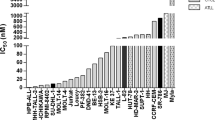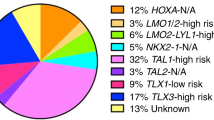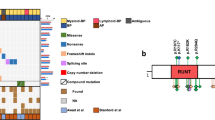Abstract
We explored the impact of mutations in the NOTCH1, FBW7 and PTEN genes on prognosis and downstream signaling in a well-defined cohort of 47 patients with pediatric T-cell acute lymphoblastic leukemia (T-ALL). In T-ALL lymphoblasts, we identified high-frequency mutations in NOTCH1 (n=16), FBW7 (n=5) and PTEN (n=26). NOTCH1 mutations resulted in 1.3- to 3.3-fold increased transactivation of an HES1 reporter construct over wild-type NOTCH1; mutant FBW7 resulted in further augmentation of reporter gene activity. NOTCH1 and FBW7 mutations were accompanied by increased median transcripts for NOTCH1 target genes (HES1, DELTEX1 and cMYC). However, none of these mutations were associated with treatment outcome. Elevated HES1, DELTEX1 and cMYC transcripts were associated with significant increases in transcript levels of several chemotherapy relevant genes, including MDR1, ABCC5, reduced folate carrier, asparagine synthetase, thiopurine methyltransferase, BCL2 and dihydrofolate reductase. PTEN transcripts positively correlated with HES1 and cMYC transcript levels. Our results suggest that (1) multiple factors should be considered with attempting to identify molecular-based prognostic factors for pediatric T-ALL, and (2) depending on the NOTCH1 signaling status, modifications in the types or dosing of standard chemotherapy drugs for T-ALL, or combinations of agents capable of targeting NOTCH1, AKT and/or mTOR with standard chemotherapy agents may be warranted.
This is a preview of subscription content, access via your institution
Access options
Subscribe to this journal
Receive 12 print issues and online access
$259.00 per year
only $21.58 per issue
Buy this article
- Purchase on Springer Link
- Instant access to full article PDF
Prices may be subject to local taxes which are calculated during checkout



Similar content being viewed by others
References
Kersey JH . Fifty years of studies of the biology and therapy of childhood leukemia. Blood 1997; 90: 4243.
Pui CH, Evans WE . Treatment of acute lymphoblastic leukemia. N Engl J Med 2006; 354: 166–178.
Pui CH, Relling MV, Downing JR . Acute lymphoblastic leukemia. N Engl J Med 2004; 350: 1535–1548.
Armstrong SA, Look AT . Molecular genetics of acute lymphoblastic leukemia. J Clin Oncol 2005; 23: 6306–6315.
Uckum FM, Sensel MG, Sun L, Steinherz PG, Trigg ME, Heerema NA et al. Biology and treatment of childhood T-lineage acute lymphoblastic leukemia. Blood 1998; 91: 735–746.
Ferrando AA, Neuberg DS, Staunton J, Loh ML, Huard C, Raimondi SC et al. Gene expression signatures define novel oncogenic pathways in T cell acute lymphoblastic leukemia. Cancer Cell 2002; 1: 75–87.
Ellisen LW, Bird J, West DC, Soreng AL, Reynolds TC, Smith SD et al. TAN-1, the human homolog of the Drosophila notch gene, is broken by chromosomal translocations in T lymphoblastic neoplasms. Cell 1991; 66: 649–661.
Miele L . Notch signaling. Clin Cancer Res 2006; 12: 1074–1079.
Artavanis-Tsakonas S, Rand MD, Lake RJ . Notch signaling: cell fate control and signal integration in development. Science 1999; 284: 770–776.
Lawrence N, Klein T, Brennan K, Martinez Arias A . Structural requirements for notch signaling with delta and serrate during the development and patterning of the wing disc of Drosophila. Development 2000; 127: 3185–3195.
Rebay I, Fleming RJ, Fehon RG, Cherbas L, Cherbas P, Artavanis-Tsakonas S . Specific EGF repeats of Notch mediate interactions with Delta and Serrate: implications for Notch as a multifunctional receptor. Cell 1991; 67: 687–699.
Sanchex-Irizarry C, Carpenter AC, Weng AP, Pear WS, Aster JC, Blacklow SC . Notch subunit heterodimerization and prevention of ligand-independent proteolytic activation depend, respectively, on a novel domain and the LNR repeats. Mol Cell Biol 2004; 24: 9265–9273.
Brou C, Logeat F, Gupta N, Bessia C, LeBail O, Doedens JR et al. A novel proteolytic cleavage involved in Notch signaling: the role of the disintegrin-metalloprotease TACE. Mol Cell 2000; 5: 207–216.
Mumm JS, Schroeter EH, Saxena MT, Griesemer A, Tian X, Pan DJ et al. A ligand-induced extracellular cleavage regulates gamma-secretase-like proteolytic activation of Notch1. Mol Cell 2000; 5: 197–206.
Shah S, Lee SF, Tabuchi K, Hao YH, Yu C, LaPlant Q et al. Nicastrin functions as a gamma-secretase-substrate receptor. Cell 2005; 122: 435–447.
Lai ED . Keeping a good pathway down: transcriptional repression of Notch pathway target genes by CSL proteins. EMBO Rep 2002; 3: 840–845.
McGill MA, McGlade CJ . Mammalian numb proteins promote Notch1 receptor ubiquitination and degradation of the Notch1 intracellular domain. J Biol Chem 2003; 278: 23196–23203.
Izon DJ, Aster JC, He Y, Weng A, Karnell FG, Patriub V et al. Deltex1 redirects lymphoid progenitors to the B cell lineage by antagonizing Notch1. Immunity 2002; 16: 231–243.
Oberg C, Li J, Pauley A, Wolf E, Gurney M, Lendahl U . The Notch intracellular domain is ubiquitinated and negatively regulated by the mammalian Sel-10 homolog. J Biol Chem 2001; 276: 35847–35853.
Yun TJ, Bevan MJ . Notch-regulated ankyrin-repeat protein inhibits notch1 signaling: multiple notch1 signaling pathways involved in T cell development. J Immunol 2003; 170: 5834–5841.
Malyukova A, Dohda T, von der Lehr N, Akhondi S, Corcoran M, Heyman M et al. The tumor suppressor gene hCDC4 is frequently mutated in human T-cell acute lymphoblastic leukemia with functional consequences for Notch signaling. Cancer Res 2007; 67: 5611–5616.
O’Neil J, Grim J, Strack P, Rao S, Tibbitts D, Winter C et al. FBW7 mutations in leukemic cells mediate NOTCH pathway activation and resistance to {gamma}-secretase inhibitors. J Exp Med 2007; 204: 1813–1824.
Yamamoto N, Yamamoto S, Inagaki F, Kawaichi M, Fukamizu A, Kishi N et al. Role of Deltex-1 as a transcriptional regulator downstream of the Notch1 receptor. J Biol Chem 2001; 276: 45031–45040.
Iso T, Kedes L, Hamamori Y . HES and HERP families: multiple effectors of the Notch signaling pathway. J Cell Physiol 2003; 194: 237–255.
Weng AP, Millholland JM, Yashiro-Ohtani Y, Arcangeli ML, Lau A, Wai C et al. c-MYC is an important direct target of Notch1 in T-cell acute lymphoblastic leukemia/lymphoma. Genes Dev 2006; 20: 2096–2109.
Rangarajan A, Talora C, Okuyama R, Nicolas M, Mammucari C, Oh H et al. Notch signaling is a direct determinant of keratinocyte growth arrest and entry into differentiation. EMBO J 2001; 20: 3427–3436.
Deftos ML, Huang E, Ojala EW, Forbush KA, Bevan MJ . Notch1 signaling promotes the maturation of CD4 and CD8 SP thymocytes. Immunity 2000; 13: 73–84.
Reizis B, Leder P . Direct induction of T lymphocyte-specific gene expression by the mammalian Notch signaling pathway. Genes Dev 2002; 16: 295–300.
Ronchini C, Capobianco AJ . Induction of cyclin D1 transcription and CDK2 activity by Notch(ic): Implication for cell cycle disruption in transformation by Notch(ic). Mol Cell Biol 2001; 21: 5925–5934.
Jehn BM, Bielke W, Pear WS, Osborne BA . Cutting edge: protective effects of Notch-1 on TCR-induced apoptosis. J Immunol 1999; 162: 635–638.
Vilimas T, Mascarenhas J, Palomero T, Mandal M, Buonamici S, Meng F et al. Targeting the NF-kappaB signaling pathway in Notch1-induced T-cell leukemia. Nat Med 2007; 13: 70–77.
Palomero T, Sulis ML, Cortina M, Real PJ, Barnes K, Ciofai M et al. Mutational loss of PTEN induces resistance to NOTCH1 inhibition in T-cell leukemia. Nat Med 2007; 13: 1203–1210.
Chan SM, Weng AP, Tibshirani R, Aster JC, Utz PJ . Notch signals positively regulate activity of the mTOR pathway in T-cell acute lymphoblastic leukemia. Blood 2007; 110: 278–286.
Weng AP, Ferrando AA, Lee W, Morris IV JP, Silverman LB, Sanchez-Irizarry C et al. Activating mutations of NOTCH1 in human T cell acute lymphoblastic leukemia. Science 2004; 306: 269–271.
Zhu YM, Zhao WL, Fu JF, Shi JY, Pan Q, Hu J et al. Notch mutations in T-cell acute lymphoblastic leukemia: prognostic significance and implication in multifactorial leukemogenesis. Clin Cancer Res 2006; 12: 3043–3049.
Breit S, Stanulla M, Flohr T, Schrappe M, Ludwig WD, Tolle G et al. Activating NOTCH1 mutations predict favorable early treatment response and long-term outcome in childhood precursor T-cell lymphoblastic leukemia. Blood 2006; 108: 1151–1157.
Mansour MR, Linch DC, Foroni L, Goldstone AH, Gale RE . High incidence of Notch-1 mutations in adult patients with T-cell acute lymphoblastic leukemia. Leukemia 2006; 20: 537–539.
Grabher C, von Boehmer H, Look AT . Notch1 activation in the molecular pathogenesis of T-cell acute lymphoblastic leukaemia. Nat Rev Cancer 2006; 6: 347–359.
Malecki MJ, Sanchez-Irizarry C, Mitchell JL, Histen G, Xu ML, Aster JC et al. Leukemia-associated mutations within the NOTCH1 heterodimerization domain fall into a least two distinct mechanistic classes. Mol Cell Biol 2006; 26: 4642–4651.
Thompson BJ, Buonamici S, Sulis ML, Palomero T, Vilimas T, Basso G et al. The SCFFBW7 ubiquitin ligase complex as a tumor suppressor in T cell leukemia. J Exp Med 2007; 204: 1825–1835.
van Grotel M, Meijerink JPP, van Wering ER, Langerak AW, Beverloo HB, Buijs-Gladdines JGCAM et al. Prognostic significance of molecular-cytogenetic abnormalities in pediatric T-ALL is not explained by immunophenotypic differences. Leukemia 2008; 22: 124–131.
Asnafi V, Buzyn A, Le Noir S, Baleydier F, Simon A, Beldjord K et al. NOTCH1/FBXW7 mutation identifies a large subgroup with favourable outcome in adult T-cell acute lymphoblastic leukemia (T-ALL): a GRAALL study. Blood 2009, (in press).
Ge Y, Haska CL, Lafiura K, Devidas M, Linda SB, Liu M et al. Prognostic role of the reduced folate carrier, the major membrane transporter for methotrexate, in childhood acute lymphoblastic leukemia: a report from the Children's Oncology Group. Clin Cancer Res 2007; 13: 451–457.
SAS Institute Inc. SAS OnlineDoc® 913. SAS Institute Inc: Cary, NC, 2005.
R Development Core Team. A language and environment for statistical computing. R Foundation for Statistical Computing, Vienna, Austria. ISBN 3-9000051-07-0, URL: http://www.R-project.org 2005.
Whelan JT, Forbes SL, Bertrand FE . CBF-1 (RBP-J kappa) binds to the PTEN promoter and regulates PTEN gene expression. Cell Cycle 2007; 6: 80–84.
Silva A, Yunes JA, Cardoso BA, Martins LR, Jotta PY, Abecasis M et al. PTEN posttranslational inactivation and hyperactivation of the PI3K/Akt pathway sustain primary T cell leukemia viability. J Clin Invest 2008; 118: 3762–3774.
Reedijk M, Odorcic S, Chang L, Zhang H, Miller N, McCready DR et al. High-level coexpression of JAG1 and NOTCH1 is observed in human breast cancer and is associated with poor overall survival. Cancer Res 2005; 65: 8530–8537.
Santagata S, Demichelis F, Riva A, Varambally S, Hofer MD, Kutok JL et al. JAGGED1 expression is associated with prostate cancer metastasis and recurrence. Cancer Res 2004; 64: 6854–6857.
Fortini ME . Gamma-secretase-mediated proteolysis in cell-surface-receptor signaling. Nat Rev Mol Cell Biol 2002; 3: 673–684.
Acknowledgements
This work was supported by grant CA76641 from the National Cancer Institute, National Institutes of Health, grants from St Baldrick's Foundation, Leukemia Research Life (Detroit) and from the Sehn Family Foundation, the Dale Meyer Memorial Endowment for Leukemia Research, and the Ring Screw Textron Chair in Pediatric Cancer Research. Ms Gedman was supported by NIH training grant T32-CA009531. Dr Taub is a Scholar in Clinical Research of the Leukemia and Lymphoma Society. We thank the Children's Oncology Group ALL Biology Subcommittee for providing the clinical specimens and clinical data that made this study possible. The experimental insight and advice of Dr Zhanjun Hou (Karmanos Cancer Institute) with the NOTCH1 and FBW7 mutagenesis is greatly appreciated. Finally, we thank Dr Spyros Artavanis-Tsakonas (Harvard University, Cambridge, MA, USA) for providing wild-type NOTCH1 in pcDNA3 and Dr Lucio Miele (Loyola University, Chicago, IL, USA) for the gift of ICN1 in pcDNA3.
Author information
Authors and Affiliations
Corresponding author
Additional information
Supplementary Information accompanies the paper on the Leukemia website (http://www.nature.com/leu)
Rights and permissions
About this article
Cite this article
Larson Gedman, A., Chen, Q., Kugel Desmoulin, S. et al. The impact of NOTCH1, FBW7 and PTEN mutations on prognosis and downstream signaling in pediatric T-cell acute lymphoblastic leukemia: a report from the Children's Oncology Group. Leukemia 23, 1417–1425 (2009). https://doi.org/10.1038/leu.2009.64
Received:
Revised:
Accepted:
Published:
Issue Date:
DOI: https://doi.org/10.1038/leu.2009.64
Keywords
This article is cited by
-
Idasanutlin and navitoclax induce synergistic apoptotic cell death in T-cell acute lymphoblastic leukemia
Leukemia (2023)
-
Pediatric T-cell acute lymphoblastic leukemia blast signature and MRD associated immune environment changes defined by single cell transcriptomics analysis
Scientific Reports (2023)
-
Comprehensive Study of Human FBXW7 Deleterious nsSNP’s Functional Inference and Susceptibility to Gynaecological Cancer
Applied Biochemistry and Biotechnology (2022)
-
Inhibition of mitochondrial complex I reverses NOTCH1-driven metabolic reprogramming in T-cell acute lymphoblastic leukemia
Nature Communications (2022)
-
Targeted sequencing to identify genetic alterations and prognostic markers in pediatric T-cell acute lymphoblastic leukemia
Scientific Reports (2021)



